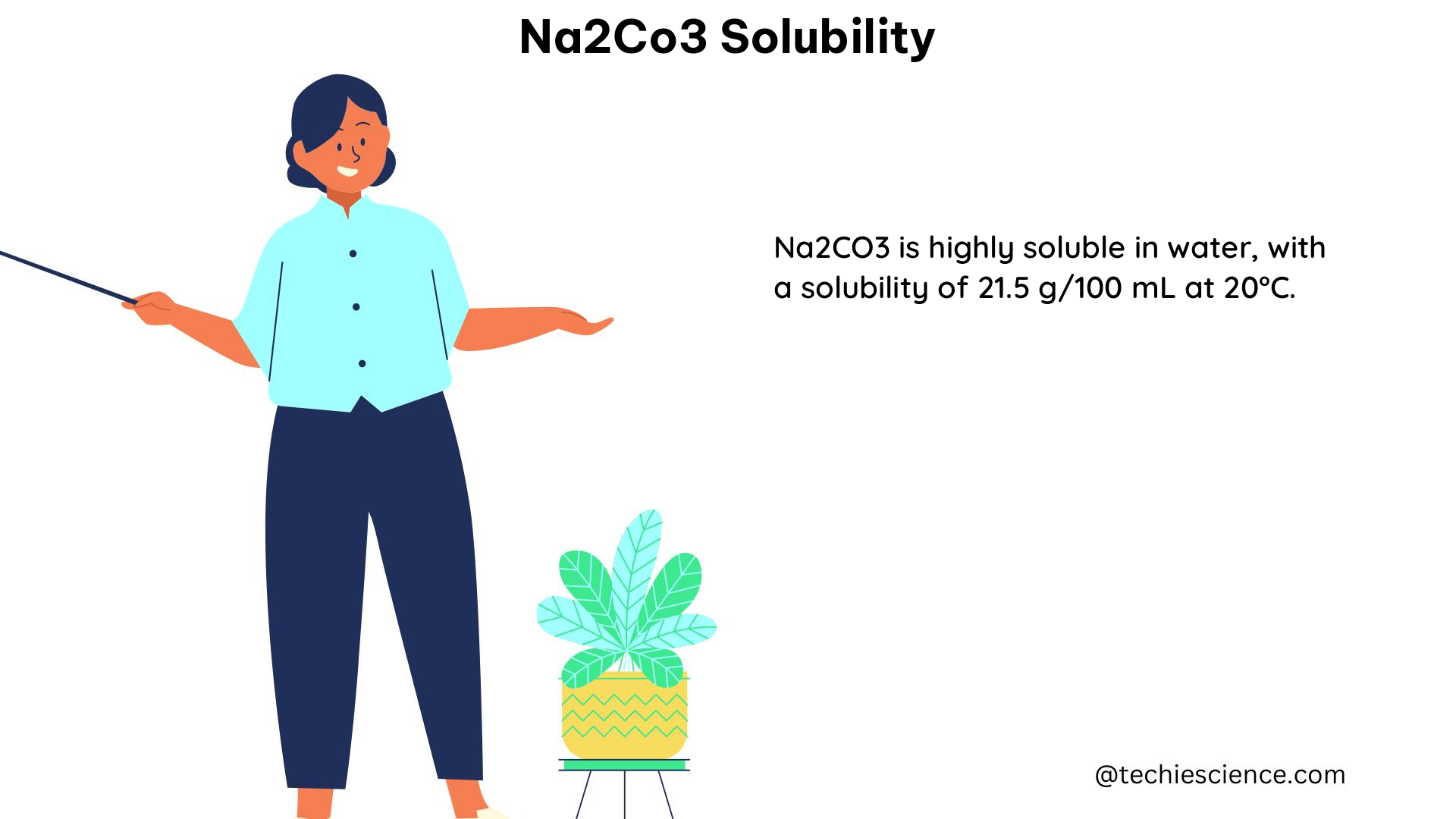Sodium carbonate (Na2CO3), also known as washing soda or soda ash, is a white crystalline solid with a range of industrial and commercial uses. Its solubility in water is an important property that determines its behavior in various applications, such as in the production of glass, detergents, and water treatment.
Understanding the Solubility of Na2CO3 in Water
The solubility of Na2CO3 in water is influenced by several factors, including temperature and the presence of other ions in the solution.
Temperature Dependence of Na2CO3 Solubility
According to the Practical Analytical 1 Chemistry handbook, the solubility of Na2CO3 in water at 20°C is approximately 10.6 g/100 mL. This means that 100 mL of water can dissolve up to 10.6 g of Na2CO3 at this temperature. However, the solubility of Na2CO3 increases with temperature, as shown in the table below:
| Temperature (°C) | Solubility (g/100 mL) |
|---|---|
| 0 | 6.4 |
| 10 | 7.8 |
| 20 | 10.6 |
| 30 | 14.6 |
| 40 | 19.8 |
| 50 | 26.2 |
| 60 | 34.2 |
This temperature dependence can be described by the following equation:
ln(S) = A + B/T
where S is the solubility of Na2CO3 in g/100 mL, T is the absolute temperature in Kelvin, and A and B are constants that depend on the specific system.
Effect of Other Ions on Na2CO3 Solubility
The solubility of Na2CO3 is also affected by the presence of other ions in the solution. For example, the solubility of Na2CO3 decreases in the presence of sodium hydroxide (NaOH) due to the formation of a less soluble compound, sodium bicarbonate (NaHCO3):
Na2CO3 + NaOH → 2NaHCO3
On the other hand, the solubility of Na2CO3 increases in the presence of acids due to the formation of soluble carbonic acid (H2CO3):
Na2CO3 + H2O + CO2 → 2NaHCO3
The eutectic solubility lines of the ternary system NaHCO3–Na2CO3–H2O were determined experimentally and calculated with the extended UNIQUAC model. The results showed that the solubility of Na2CO3 in water decreases with increasing concentration of NaHCO3, and that the presence of a small amount of aqueous CO2 has only a small influence on the equilibrium compositions and temperatures.
Solubility of Na2CO3 in Organic Solvents

In addition to its solubility in water, Na2CO3 also exhibits significant solubility in various organic solvents, including alcohols, ketones, and esters. This property is exploited in the production of various organic compounds, such as cellulose derivatives and surfactants.
The solubility of Na2CO3 in organic solvents can be described by the following equation:
ln(S) = A + B/T + C*ln(T)
where S is the solubility of Na2CO3 in the organic solvent, T is the absolute temperature in Kelvin, and A, B, and C are constants that depend on the specific solvent and system.
For example, the solubility of Na2CO3 in ethanol at 25°C is approximately 0.5 g/100 mL, while in acetone it is around 2.0 g/100 mL.
Applications of Na2CO3 Solubility
The solubility of Na2CO3 in water and organic solvents is an important property that determines its behavior in various applications, such as:
-
Glass Production: Na2CO3 is used as a flux in the production of glass, where its solubility in the molten glass mixture helps to lower the melting point and improve the workability of the glass.
-
Detergent Manufacturing: Na2CO3 is a key ingredient in many detergents, where its solubility in water and ability to form basic solutions help to remove dirt and grease from surfaces.
-
Water Treatment: Na2CO3 is used in water treatment processes to adjust the pH and alkalinity of the water, taking advantage of its solubility and ability to form basic solutions.
-
Organic Synthesis: The solubility of Na2CO3 in organic solvents is exploited in the production of various organic compounds, such as cellulose derivatives and surfactants.
-
pH Regulation: The solubility of Na2CO3 and its ability to form basic solutions make it useful for regulating the pH of various systems, such as in the production of pharmaceuticals and cosmetics.
Conclusion
The solubility of Na2CO3 in water and organic solvents is a critical property that determines its behavior and applications in various industries. Understanding the factors that influence the solubility of Na2CO3, such as temperature and the presence of other ions, is essential for optimizing its use in different processes and applications.
References:
- Practical Analytical 1 Chemistry. (n.d.). Retrieved from https://drive.uqu.edu.sa/_/giabulkair/files/analytical%201/Practical%20Analytical%201%20,,Chemistry.pdf
- Pascual Marcos Rodriguez Trambitas, Daniela Calvo, Elisa Saez Kramer, Herman Witkamp, & Geert-jan. (2010). Determination of the eutectic solubility lines of the ternary system NaHCO3–Na2CO3–H2O. Chemical Engineering Research and Design, 88(10), 1406–1413. https://doi.org/10.1016/j.cherd.2010.01.008
- What is Colorless? Exploring Solubility of Silicon Dioxide. (2011, July 24). Retrieved from https://www.physicsforums.com/threads/what-is-colorless-exploring-solubility-of-silicon-dioxide.516572/

The lambdageeks.com Core SME Team is a group of experienced subject matter experts from diverse scientific and technical fields including Physics, Chemistry, Technology,Electronics & Electrical Engineering, Automotive, Mechanical Engineering. Our team collaborates to create high-quality, well-researched articles on a wide range of science and technology topics for the lambdageeks.com website.
All Our Senior SME are having more than 7 Years of experience in the respective fields . They are either Working Industry Professionals or assocaited With different Universities. Refer Our Authors Page to get to know About our Core SMEs.